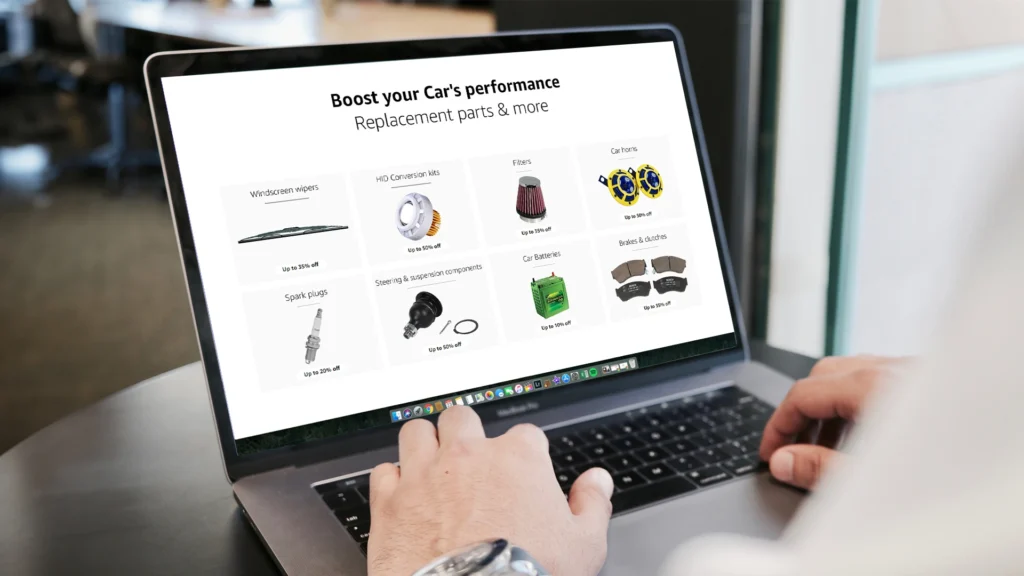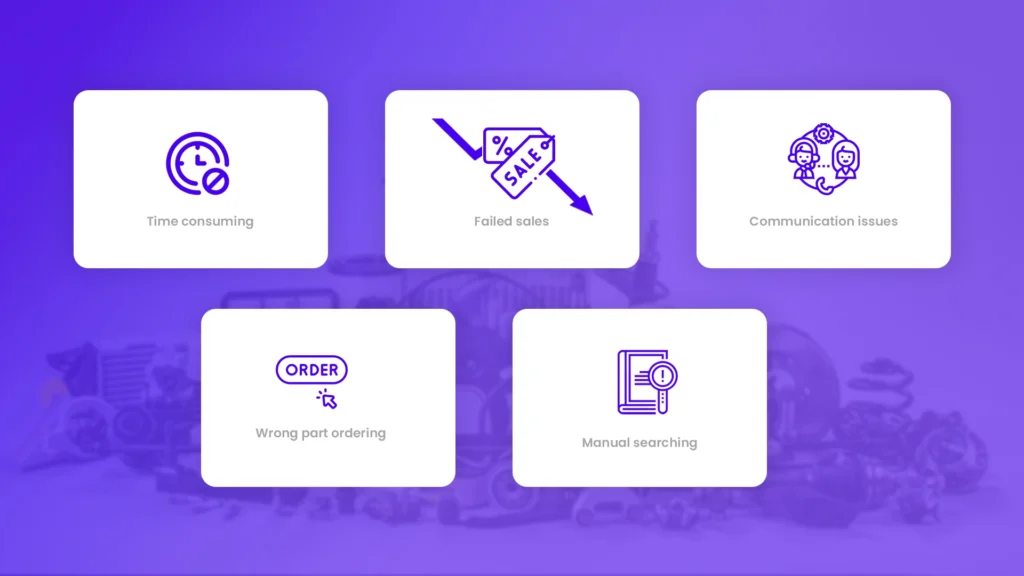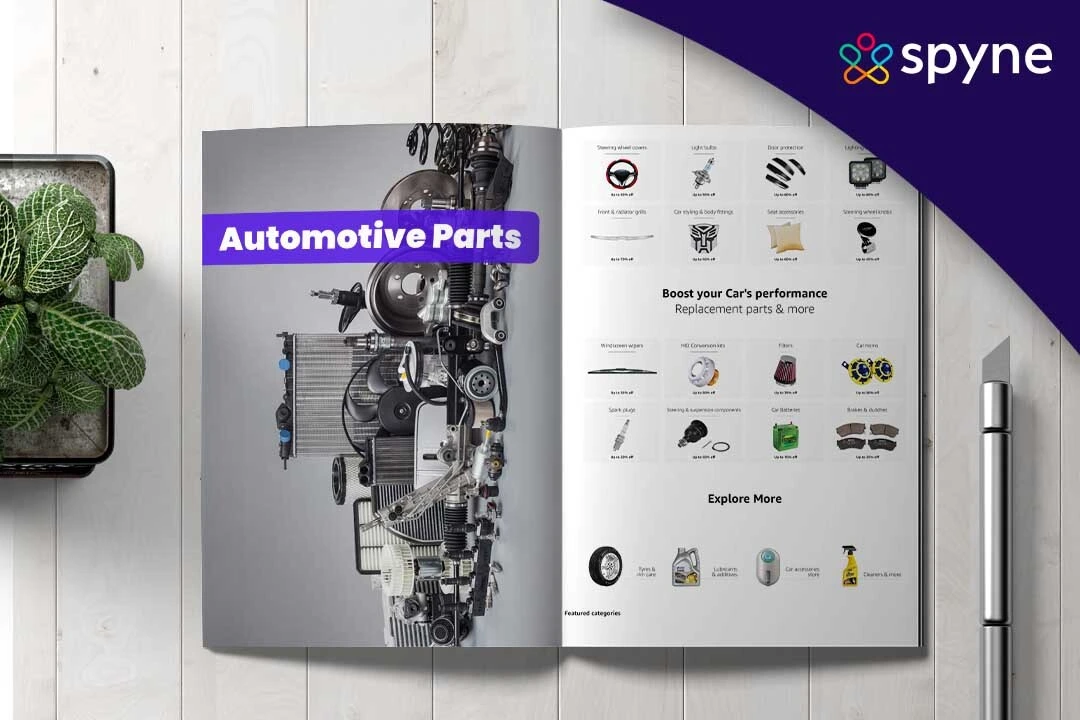Running an automotive catalog is not easy, but handling and growing your business through auto parts cataloging takes things to a different level. The auto ecommerce businesses are seeing significant growth. Many changes are now implemented, from technological innovation to customer experience. However, one can easily stay ahead if they have a complete understanding of the car parts catalog. If you are new to this term and want to know how you can benefit from automotive parts cataloging, then don’t worry; this blog will guide you through and help you elevate your automotive parts cataloging game.
What is Auto Parts Cataloging?
Auto parts cataloging is an essential part of any car parts-selling website. An automotive parts catalog database consists of an inventory list of all the parts that are available for selling and includes all the information regarding parts and their compatibility with vehicles. It also includes illustrations, part numbers and other data for cars and their parts. It can also be a printable guide that gives vehicle owners info regarding spare parts and car accessories obtainable for their car.
The catalog is used as a guide when performing maintenance procedures or repairs on a vehicle. When it comes to marketing auto parts on the internet, having details is important to help potential customers determine the compatibility of a specific part or accessory with their vehicle. It is essential now to build a catalog in the era of Ecommerce Catalogs.
Why Do You Need Auto Parts Cataloging?
If you are involved in selling car parts and deeply involved with car catalogs, then you must have an idea of how crucial it is to have a precise car parts catalog. Automobile parts cataloging not only helps customers find the right parts but also plays an important role in elevating sales. It also helps retailers find parts that they require for repair and maintenance.
It includes product narratives, images, pricing details, and other essential data that can assist patrons in identifying the appropriate automotive element for their requirements.

Creating an online car parts catalog can seem to be difficult. However, it is of extreme importance to possess one, as it allows consumers to access the information necessary for making informed buying decisions. Major eCommerce platforms such as Amazon and eBay also utilize it to evaluate potential sellers within their marketplaces.
How To Build an Auto Parts Catalog?
Building auto parts cataloging might seem daunting at first, but there are several tools that can make this process a lot easier. WordPress is a good tool that can assist you in building an auto parts online catalog. However, if you want to make use of specialized tools, then you should check out Auto Parts Warehouse to create auto parts catalogs.
When starting from scratch, establish a comprehensive database of all available car parts and car accessories for sale. Critical components of a car catalog include:
- A full list of car parts and accessories, including product descriptions, images, and availability.
- Detailed pricing information for each car part.
- Contact information for manufacturers and distributors.
- A clear numbering system for parts to help customers easily find the correct items.
- A comprehensive list of all car part types, categorized for easy navigation.
- Unique installation instructions for each part.
- Supplier and manufacturer details for transparency.
The database of your auto parts catalog database should be expansive. Consider your audience when creating the catalog. For example, if you are targeting commercial vehicles, you should create your catalog specifically for that niche.
For each part, gather important details, including the manufacturer’s name, part number, description, and any specific installation or maintenance instructions.
Top 7 Benefits of Using an Auto Parts Catalog
Auto parts cataloging has various features that one can benefit from. It is one of the best Automotive Solutions that every dealership must opt for. Here are some of the benefits of having a car parts catalog:
1) User-Friendly
An automotive part catalog is easy to use due to its simplified search and navigation features such as search filters, clickable diagrams and interactive menus for various part numbers, keywords and specific car models. These features allow the user to locate what they need in seconds and removes the need to flip through a physical catalog.
2) Efficient Inventory Management
The auto parts catalog can provide real-time updates on pricing, orders status and the availability of stock by integrating with inventory systems and. This integration eliminates human error and improves accuracy while minimizing the need to enter data manually. This helps you to track sales volume and make changes in stock if needed and hence efficiently promote automotive inventory management.
3) Immediacy
An auto parts catalog offers immediate help by accurately identifying and ordering the right parts the first time. This immediacy can save you time and money on returns, exchanges, and additional shipping costs.
4) Evaluate Multiple Suppliers
Car parts catalogs often list multiple brands or suppliers for the same part. Therefore, this allows customers to compare prices, quality, and warranty information that different suppliers offer and help customers to make an informed choice that they are comfortable with.
5) Accessibility
Many online car parts catalogs make it easy to browse and order parts from the comfort of your home or shop. This level of convenience eliminates the need of paper-based catalogs and allows people to quickly search their required information in the workshop or on the go. Another benefit that online commercial auto parts catalogs offer is real time updates. This aids users in having access to the most up to date data which minimizes errors while maximizing efficiency.
6) Cross-referencing Information
The auto parts catalogs include cross-referencing information which allows you to find alternative parts that are compatible with your vehicle. Auto Parts Catalogs also provide the most up to date parts which aids in keeping the inventory up to date and allows the technical publishers to make real-time changes.
7) Solid Customer Experience
Auto parts cataloging provides excellent experience to the customer. Every customer expects a quick and productive service, and this can be achieved by using auto parts catalogs. These catalogs help technicians procure the spare parts they need quickly which ensures prompt repairs. By utilizing these catalogs, technicians have extensive information regarding troubleshooting and installation at their fingertips, which helps them answer customer questions coherently. All these attributes lead to customer satisfaction and provide them with an overall solid experience.
Features Needed For an Auto Parts Catalog
While creating your auto parts catalog, you must add some of these features that we are going to discuss. Some of these solutions are compatible with catalogs from various systems, irrespective of the platform employed by the company. The following are examples of attributes that could improve the efficiency of your catalog:
1) My Garage Feature
This can be an essential tool for any car owners since this feature will allow them to keep track of the car parts that are sold or purchased. Users should have the capability to include multiple vehicles in their digital garages. This functionality enables customers and consumers to easily switch between their favorite automobiles, offering a more efficient alternative to repeatedly performing the same task.
2) A Wish List Feature
Through this feature, interested customers can easily add auto parts to their wish list, which will allow them to save it for later. This functionality will additionally allow you to monitor car parts that have caught customers’ interest but have not yet been acquired.
3) A Rating and Review Feature
Customers have the chance to share their reviews and provide ratings for the car parts they’ve acquired from your catalog. This serves as an excellent opportunity to gather valuable feedback regarding the quality of the car parts you provide. Furthermore, it enables you to discern which car parts resonate well with customers and those that may need improvement.
4) A Comparison Feature
This feature of auto parts cataloging allows customers to conduct side-by-side comparisons of car parts, helping them make informed and optimal purchasing choices. It proves particularly valuable when considering car parts with similar functionalities but varying price points. You can also add or create sections that can be for different types of car parts and manage your information alphabetically by supplier or manufacturer. You can also make a numbering system for your auto parts catalog.
5) A Parts Diagram Feature
Incorporating a parts diagram into your car parts catalog would prove highly beneficial. This visual aid enables customers to grasp how the car part seamlessly integrates into the broader system of their vehicle. Typically, this functionality is presented as an interactive image showcasing various automotive components. When users click on a specific part number, they are redirected to the corresponding webpage, offering detailed information. Considering that even automotive experts sometimes grapple with identifying precise names for specific car parts and gadgets, the inclusion of part diagrams is invaluable.
6) A Payment Tool Feature
Implementing a payment feature within your car parts cataloging would streamline the purchasing process for customers, enabling them to make direct payments for car parts. This payment system should easily integrate with the year/make/model search function, ensuring swift and accurate component selection for consumers. Additionally, it should support a range of payment methods, including credit cards, debit cards, and PayPal, to accommodate diverse customer preferences.
7) Multiple Shipment Options
Offering customers a range of shipping choices is essential to ensure prompt delivery of their car parts. Depending on their preferences, they may opt for home or workplace delivery or prefer to collect the parts from a nearby store. Therefore, these shipping options should seamlessly integrate with the year/make/model search tool, allowing customers to efficiently pinpoint the correct component for their vehicle.
8) A Fitment Search Filter
A fitment search filter is a vital constituent in an online auto parts store as it eliminates the need to browse through various categories when looking for a particular car component. So, a fitment search filter is needed when a customer wants to search for a particular car part amongst thousands of other parts and accessories. It only shows those components that fit the particular year/make/model that the customer is searching for.
How to Manage and Maintain Your Auto Parts Cataloging?
One thing about managing auto parts catalog is keeping it updated regularly so that it remains accurate as needed. You must check for new auto parts and renew your catalog as required. Additionally, look for car part prices and ensure that your catalog showcases those changes.
Also, here are more tips for managing your catalog:
1) Execute Barcode System
Improving Car Inventory Management for ease, efficiency, and organization can be achieved through the implementation of a barcode system. Barcoding and scanning increase organization and accuracy by digitally tracking your inventory through multiple means. So, automotive parts barcoding systems are typically integrated with inventory management software, ensuring that all essential inventory data is readily available in the easily accessible cloud.

2) Use the ABC Analysis Method
While every component of a car holds significance, certain parts are absolutely critical to maintain within your inventory figures. It’s crucial to pinpoint and effectively manage your most vital assets. One highly effective approach for achieving this is by employing the ABC analysis method.
3) Keep Track of Pricing
In order to maintain an organized management system, it’s essential to consistently monitor pricing. This practice ensures that you never overspend on any particular part. If the price offered by your vendor doesn’t align with the average price for the part, then you need to ask for clarification.
4) Work Together with Vendors
Collaborating with vendors is a valuable strategy to control costs, and applying this approach from the outset is advisable. You can compare the prevailing rates for your parts with your vendor’s offerings. This approach ensures that your automotive part prices remain competitive and consistent for both you and your customers.
5) Update Auto Listings
Keep an eye out for new releases of automobiles since your last catalog update. Also, check for any changes carried out by an auto manufacturer to existing vehicles such as change in transmission options or engine options. Update this information in your catalog and remove any invalid entries.
How Does an Accurate Auto Parts Catalog Help Increase Sales?
To increase sales, one must have the right strategy. Here are a few tips that will help you elevate your sales:
1) Increase Sales of Manufacturer Auto Parts
It’s important to recognize that not all parts are created equal. While a repair shop might initially consider opting for non-manufacturer parts due to their lower cost, the long-term value may not align with this perception.
While the aftermarket offers a wide range of parts compared to manufacturer options, this extensive selection comes with its own challenges. Evaluating pricing, brands, quality, and compatibility for a wide array of aftermarket parts can be time-consuming for both you and the repair shop. Your parts department could otherwise utilize this extra time spent on parts discussion to enhance sales and customer service for other clients.
2) Allow Shops to Order Manufacturer Parts Online
When a vehicle takes up space in the shop, it not only incurs costs for the parts installer but also poses a potential revenue setback. The aftermarket has been effective in providing online accessibility for auto parts procurement, ensuring that repair shops can make quick and convenient purchases. However, to remain competitive with aftermarket online parts ordering technology and encourage repair shops to increase their purchases from your inventory, consider offering an online catalog of manufacturer replacement parts.
3) Utilize Technology Effectively
The key to profitability versus merely breaking even lies in efficient order processing. Therefore, selecting dependable software can streamline the process of ordering manufacturer parts, facilitating faster and error-free communication between dealers and repair shops.
4) Robust Search Efficacy
Auto Parts Catalogs have robust search functionality like built-in Year/Make/Model search filters that help by providing accurate data when a user is searching for specific parts in the catalog. The Catalogs also have the ability to search by VIN (vehicle identification number) to make sure that the parts are fully compatible with the corresponding vehicle.
5) Dedicated Server for Hosting
Opting for dedicated hosting can provide your store with additional power and speed that would lead to faster response times. It will also be beneficial for the security of your online store as it will help reduce the risk of outages.
6) Trusted Automotive Database Integration
You can keep your product catalogs clean and updated without much effort by accessing extensive automotive databases like SEMA Data (Specialty Equipment Manufacturers Association) or ASAP Network – Aftermarket Daa (Aftermarket Automotive Suppliers Association). These databases will give you relevant technical details on car parts and accessories that are available today.
7) Intuitive Storefront Navigation
Excessive clutter on your storefront is an excellent way to make customers avoid your website. Keep the navigation of your website and catalog transparent and convenient to improve the loyalty of your customers. You can also enhance brand recognition and consistency by improving your website and catalog with more features and images that align with your brand.
How Does Automotive Spare Parts Catalog Software Help OEMs?
Every automobile is built of a delicate assembly of various small components and spare parts, and manufacturers must contend with a multitude of these vehicles. Therefore, the manual tracking of numerous small parts proves to be a challenge, demanding significant labor. Manufacturers are tasked with the burden of maintaining or creating manual catalogs, a process filled with numerous other challenges.
Auto part catalog software helps in a great way with auto parts cataloging since it has proved to be efficient and effective. Their advantages include :
- Intellinet’s automotive parts catalog software allows dealers to initiate orders directly within the module. Therefore, parts can be located by utilizing their respective part numbers, and orders can be seamlessly placed with the guidance provided on-screen.
- When new and enhanced parts are introduced, updates can be effortlessly applied through the online module with just a few clicks, and this information is instantly visible to dealers in real-time.
- This catalog software assists in part identification using part numbers or visual figure searches.
Challenges Solved by Auto Parts Cataloging
We have gone through some of the benefits the automotive parts catalog can provide. However, the implementation of your catalog addresses several challenges, which we have detailed below:
1) Manual Searching
An automotive parts store typically carries a huge inventory of thousands of car parts. The sheer volume of these components can make it challenging for customers to locate the specific parts they require, especially considering that compatibility issues can arise.
By utilizing a car parts catalog, customers can save valuable time, as they no longer need to engage in manual research to identify compatible parts.

2) Wrong Part Ordering
Humans are capable of making errors due to the requirement for data cross-checking repeatedly. A car part catalog can eliminate this issue and solve it by automatically matching part numbers with the correct cross reference.
3) Communication Issues
Effective communication with manufacturers can prove challenging without a car parts catalog that includes essential details like part numbers. For instance, when there’s a change in the specifications of a particular car part, addressing such issues can be a time-consuming process for car part sellers. Therefore, it’s advisable to prevent such errors from occurring in the first place. Using an API-driven automotive part catalog will enable you to communicate with your partners.
4) Failed Sales
A centralized parts catalog is important in helping car part sellers manage their inventories effectively. In fact, neglecting to utilize one can have a detrimental effect on the store’s sales performance. Customers are eager to locate the necessary parts swiftly, and the absence of an integrated central catalog can lead to time-consuming searches for the right component. Therefore, without a proper search function and a functional car part catalog, your customers’ experience may become cluttered, hindering their ability to enjoy the high-quality service they have come to anticipate in today’s e-commerce environment.
5) Time-consuming Ordering Process
Manual labor is both time-consuming and prone to errors. Without the assistance of a car part catalog, the ordering process becomes needlessly complex. Customers rarely have the luxury of time to sift through all the available parts within a store, further delaying the ordering process.
The integration of a car part catalog significantly streamlines part management. It provides a clear overview of stock availability, making it easier to identify out-of-stock items and promptly update their status within the system.
Conclusion
In conclusion, running an automotive parts catalog is essential for businesses in the auto industry. The growth of auto eCommerce businesses is evident, and staying ahead requires a complete understanding of the benefits of auto parts cataloging. Therefore, this catalog serves as a crucial reference for customers, helping them identify compatible parts and make informed buying decisions.




























